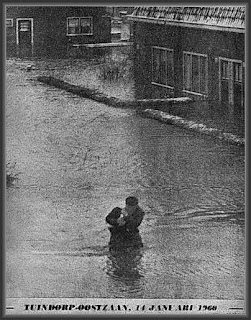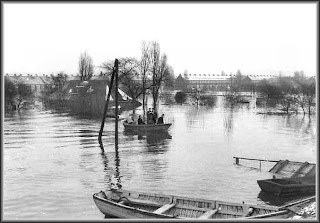At the time Ruud was only 19 years old and was a member of the Zandvoort Water Life Saving Association, and so was I.
In the summer we were life guards on the busy beaches of Zandvoort in The Netherlands,where we were living. Zandvoort is a big tourist place on the North Sea, which attracts a lot of people from all over Europe.
Ruuds father was the president of this Lifeboat Association.He also was a member of the board of the KNBRD, which means "Royal Dutch Water Life Saving Association". He did volunteer work for this association for numerous years. When he retired he told in his goodbye speech that he could not swim. Every body burst out laughing. A member of this Association of the Royal Water Life and he can't swim, that is hilarious.He was honored by Queen Juliana for his work, and was presented with a medal of Honor of Oranje Nassau.
 |
| Queen Juliana from The Netherlands present Ruud's father with the medal of Honor on March 15,1972. |
 |
| Father Joop Gerardus Bisenberger at the guard-house on the beach. |
In the summer you could always find Ruud and me on the beach of Zandvoort.We were life guards.The sea can be extremely dangerous.When the tide comes in we had to watch for rip tides, and made the swimmers aware of this with a sign telling them not to swim in that area. They exist between the sandbars. A rip tide current will drag a swimmer out to sea.
Most swimmers panic and try to swim back to shore. Trying to swim back to shore against the rip tide current will only tire you out. Rip tides are narrow enough that if you swim parallel to shore, you can easily escape the current and then swim back to shore.
This picture taken in Zandvoort you see the beginning of a rip tide current. Once the tide comes in this will be totally underwater.Like I show you on the next picture.
 |
| Rip tide is a current which takes you out to sea. |
Every day on the beach was an adventure. You never knew what the day would bring.But it was fun, and we learned a lot.That is probably why we ended up in Jamaica and owned our own dive shops on the island.
 |
| I am the one in the middle on the right Benno Ball. |
 |
| Ruud on the left. |
 |
| Second on the left me again. |
Taking the boat out to sea. When the waves were high it took a bit of skill to get the boat through the surf, without getting the inside of the boat flooded. Before you knew a big wave would splash over the boat and the boat would be full of water.
 |
| Ruud his father on the left, we received two boats with engines that day. We did not have to row anymore. |
 |
| Ruud and his friend Henk Castien. Taking the new boat out to sea for a practice run. |
 |
| All the members of the board, on the far right Ruud's father Joop G. Bisenberger.The third from the left is Dr. Zwerver. |

During the flood disaster of 1960, and by assisting of the stranded people from Tuindorp Oostzaan, Ruud received this medal of honor.A beautiful medal for saving Human-life.
 |
| This side of the medal is a water monster, which takes hold of the town. |
 |
| This side of the medal is a helping hand offered. |
In the early morning of January 14,1960 a military truck drove over the dike of the Sea-Channel between Amsterdam and Zaandam. There was a lot of snow on the road and suddenly the truck driver thought it was strange that the snow looked like it had melted in the distance because it was like a very dark spot.The town of Tuindorp Oostzaan is protected by a high man made dike on this dike runs a road. It had been snowing and it was freezing cold. A truck from the military was doing it's daily duties, because in that vicinity the military had a big ammunition storage depot which had to be checked by them several times a day. They stopped the truck and to their consternation they noticed that the dike had burst, and the road was gone.Tons of water was running into the town of Tuindorp Oostzaan were the people just started to wake up.They quickly alarmed the authorities, but it was too late. The streets of the town were already flooding, there was no stopping of the water mass.The flooding of the polder-land was unstoppable.11,000 residents had to be evacuated.A massive break in the dike had occurred.Within three hours almost two meters of water had rushed into the town of Tuindorp Oostzaan.
A picture from a newspaper clipping,not very clear, but you can see where the dike broke, and the road which runs on top of the dike.
At the time Ruud was working for Garage Kooiman on the Brederodestraat as a car mecanic. His boss gave him three days off(without pay) to go and help the people from Tuindorp Oostzaan to evacuate from their houses.Three days; night and day the boats went up and down the streets to get people and animals to safety.Sometimes he came home and slept for a couple of hours and left again.It's despicable that in times like that there are always people looting. So they had to patrol the flooded streets.It took 33 hours to fill the hole in the dike and after two weeks the residents were allowed to go back to their homes. There was mud every where and the cleanup started.
The following pictures are during the rescue, it was snowing and extremely cold. He remembers it as the day of yesterday. He will never forget, that day in January 1960.
January 14, 1960. A date never to be forgotten.
The Netherlands is below sea level, man made dikes have to protect the towns and cities from the sea.It's a constant battle to make sure that the dikes will not burst.
In 1953 on New Years Eve the dikes broke, it was the worst disaster ever. One thousand eight hundred and thirty six people drowned.Thirty thousand people had to be evacuated.
The South of Holland under water.
1,000 Americans helped by this disaster in The Netherlands.
The dikes are not suppose to break!
Strongly built to protect it all
Against a force that beckons to call
Behind this wall, it's easy to live
No more to get with less to give.
In one instant, the flood rages in
Attacking that wall, wearing it thin
The onslaught becomes too much to bear
Unstoppable, without warning, no time to prepare
Pain flashes through the heart and soul
Destroying what was once thought whole
Sooner or later, the walls crumble and break
Creating inside an unbearable ache.
All at once, never in small measures
Memories invade of all past treasures.
No longer mine, they belong to another
Why would I care?Why even bother?
Although the pain is less than before
I beg to be saved from bearing it more.
I reach for the concrete and mortar of my mind.
In hopes to leave those memories behind.
Hastily rebuilding that wall of protection.
Each block in place, no room for rejection.
Built from tears and not from blood
Safe again from memories flash flood.
Unknown.
 |
| The waves are rolling in. The North Sea can be vicious. |
 |
| In Zandvoort the Dunes protect the town, which lies below sea level. |
In Zandvoort, in the North of Holland, we are protected by the Dunes. When you walk on the boulevard you can see how low the land is.The above picture shows how much the sea took away from the dunes.
27 percent of The Netherlands is actually below sea level. This area is home to over 60 percent of the country's population of 16.5 million. Climate change has the potential to increase sea levels by 20 feet(6.1 meters).The lowest city within the Netherlands lies 7 meters (23 feet) below sea level. North Sea storms could worsen, and further threaten the Netherlands.
 |
| Without dikes the blue area of the Netherlands would be under water. |




























No comments:
Post a Comment